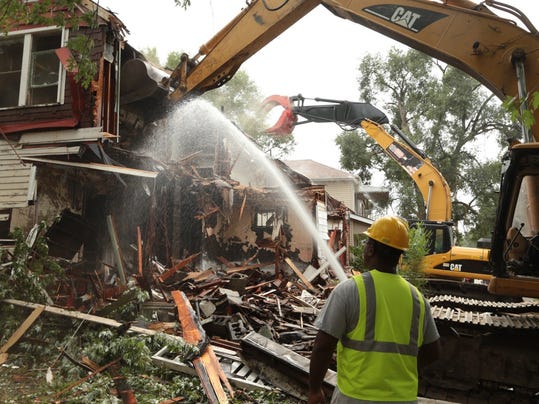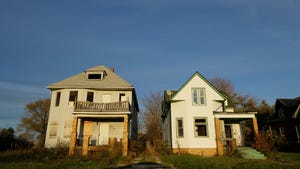WHO'S GETTING HOSED HERE?
http://www.freep.com/story/news/local/michigan/2015/01/28/blight-funds-questioned/22431115/
X
X
I FIND THE TIMING SUSPICIOUS- SEE POST ABOVE- SCROLL- HENRY STANDS TO LOSE OUT ON MILLIONS IN SCRAPPING THESE HOUSES; AND ELLSPERMANN- IS INVOLVED IN MORTGAGE BANKING AND HOME LOANS/ EQUITY; ETC..
FOLLOW THE MONEY!
X
X
Inspector: Oversight needed for anti-blight money
WASHINGTON — A federal inspector general is questioning the U.S. Treasury's decision-making in allowing hundreds of millions of dollars that were supposed to help struggling homeowners to be used to tear down thousands of abandoned properties in Detroit and across the country.
No state has received more in blight eradication funding through the Hardest Hit Fund than Michigan and no city more than Detroit. But the inspector general with authority for monitoring the program said in a report today that Treasury officials made the change to pay for anti-blight efforts without putting in place proper oversight measures or setting goals to ensure taxpayer dollars are well-spent.
In the report to Congress, Special Inspector General Christy Romero criticized the Treasury's shift toward blight eradication efforts under the $7.6-billion Hardest Hit Fund, saying it has no experience with anti-blight programs and has done nothing to explain or quantify the goals or risks involved.
Separately, Romero told the Free Press her office is auditing the $372 million committed so far to anti-blight efforts out of the Hardest Hit Fund in six states, including Michigan, where $175 million — a third of its total award — have been committed to demolition, clearance and remediation.
Five other states have shifted money under their initial Hardest Hit Fund awards to blight elimination: Alabama ($25 million), Illinois ($1.9 million), Indiana ($75 million), Ohio ($60 million) and South Carolina ($35 million).
"That's a lot of money and that's a big shift," Romero said, adding that the change came with little explanation from the Obama administration. "What's your measurement of success then? Are you going to start tracking whether it brings down foreclosures and stabilizes home values?"
Romero's reports often lead to congressional hearings, though none have been called yet on blight-elimination funding. Her office's audit this year also is expected to include recommendations that could affect Detroit and other Hardest Hit Fund recipients in the future.
Romero is special inspector general for the Troubled Asset Relief Program (TARP), the massive federal rescue program that includes the Hardest Hit Fund but also helped prop up financial institutions and kept General Motors and Chrysler solvent through bankruptcy.
The Free Press was precluded by a news embargo from immediately contacting officials who supported the funds for blight elimination. But as recently as December, Gov. Rick Snyder proclaimed it an "important step in Michigan's comeback" and an "example for what can be accomplished" when governments work together.
Michigan stands to benefit from the shift in funds more than any other state.
In June 2013, three years after the initial Hardest Hit Fund award — and at a time when only about $90 million of its award had been spent on homeowner aid — the Treasury announced it would allow the state to move $100 million into anti-blight efforts in Detroit, Flint, Grand Rapids, Pontiac and Saginaw.
Last year, Snyder and the Treasury Department announced an additional $75 million would be moved to blight eradication — about $25 million of which went to 11 new cities.
Detroit, however, is poised to receive the rest, meaning the vast majority of the funding — about $100 million in all — would go to the city. Overall, the new funding increased to 7,000 the number of properties expected to be cleared across the state.
But there seems to be conflicting information about how the funding is being spent: Using the most recent report available from the Michigan State Housing Development Authority and the Treasury, Romero's report said 816 properties had been removed or demolished in four cities — only 201 of which were in Detroit — with an additional 4,840 somewhere in the process of being acquired.
X
As recently as December, the Free Press reported that Detroit had already used its first $50 million in Hardest Hit Fund money and was tearing down as many as 200 vacant houses a week. Romero's report called for more transparency in federal, state and local reporting on how the funding is spent.
In her report, Romero did not argue against Hardest Hit Fund money being used to fight blight. But she said the Treasury, which is used to dealing with homeowners and mortgage servicers, needs "new and appropriate oversight tools to monitor its Blight Elimination program."
She said in order to protect the taxpayer investment, the Treasury needs to set firm goals for such funding; determine ways to measure the success of the program; and balance blight spending against the original plans for the Hardest Hit Fund.
Talking to the Free Press, she also said the Treasury needs to settle on a definition of what qualifies as a blighted property, as well as on what controls it maintains over the costs of acquisition and demolition.
Romero said the department also needs to determine how "greening" efforts intended to make the cleared properties valuable to a community will be judged.
In recent years, Detroit has gotten tens of millions of dollars from other federal programs as well to tear down vacant buildings. While most of that funding has now ended, there are concerns about how best to track money being spent out of different programs to ensure it is not wasted or misspent.
There also is a question about how the federal government can or would judge the success of a blight-elimination program such as through local property values or residency rates.
Since the Hardest Hit Fund was designed to keep people in their homes after the housing crisis, the Treasury could be called on to quantify how shifting money to blight removal helps homeowners.
Under Detroit's bankruptcy reorganization plan, the city is expected to spend $500 million of its own money over five years on demolition.
Contact Todd Spangler: 703-854-8947 or tspangler@freepress.com. Follow him on Twitter@tsspangler.
X
X
X



No comments:
Post a Comment